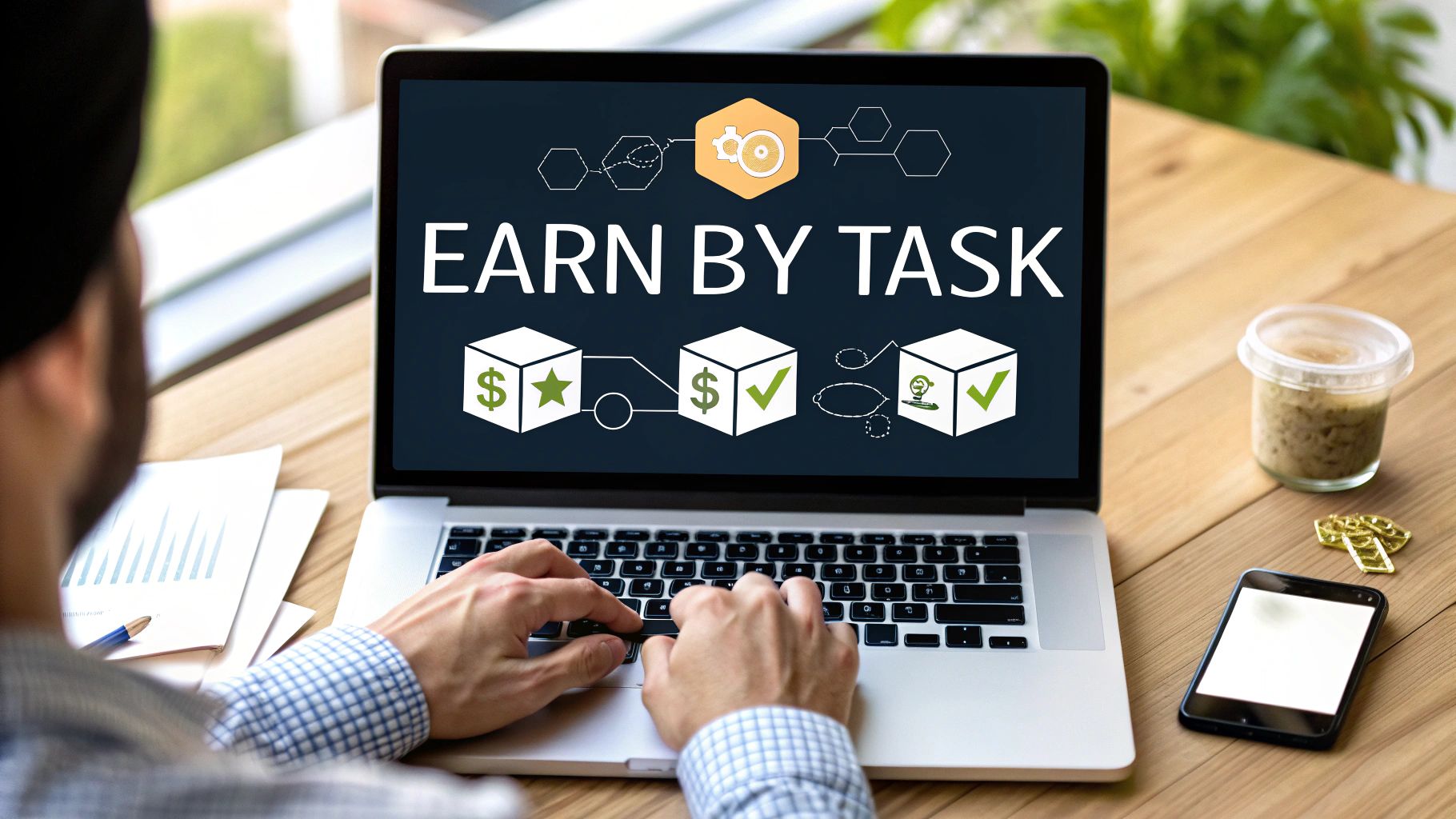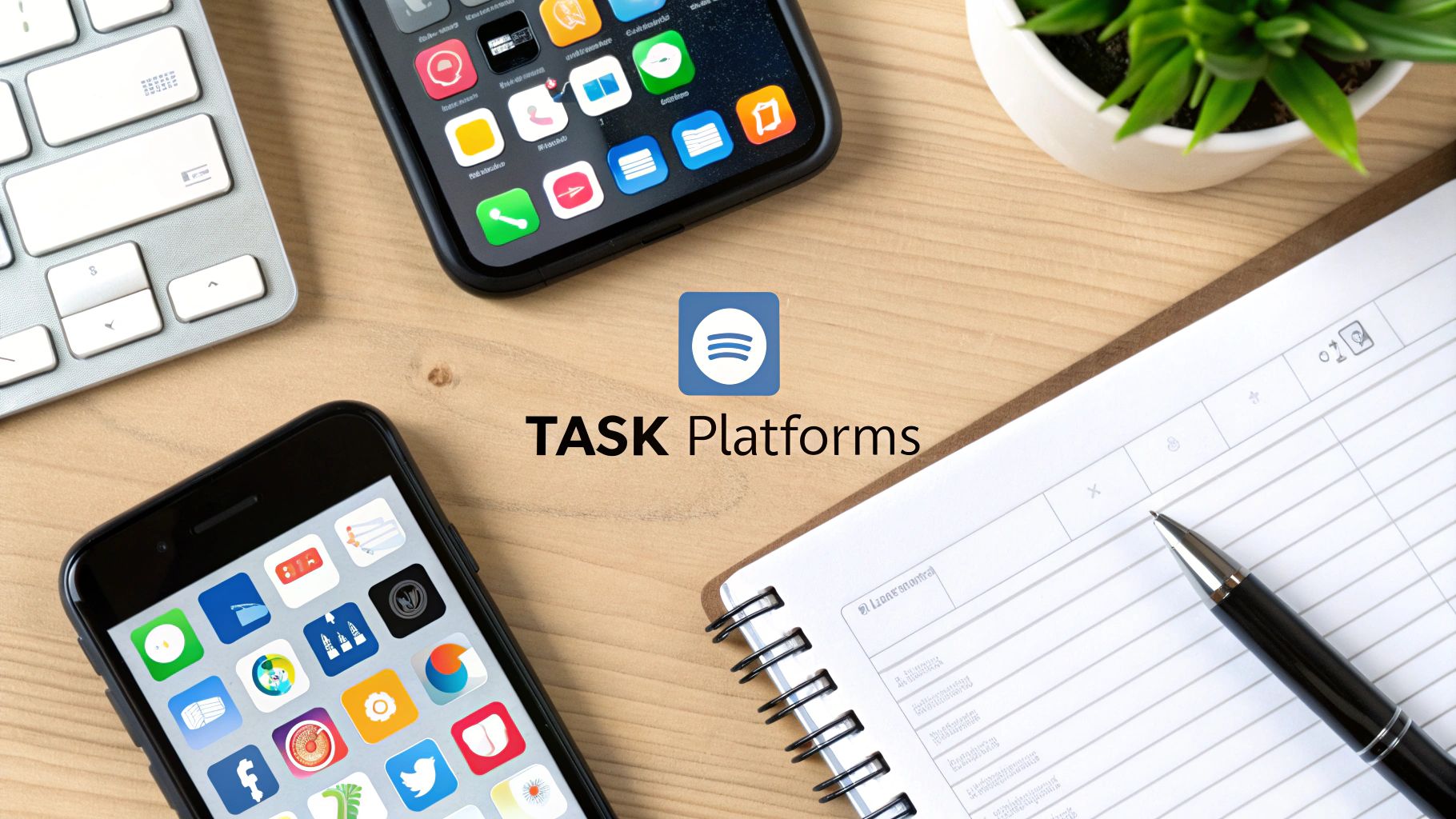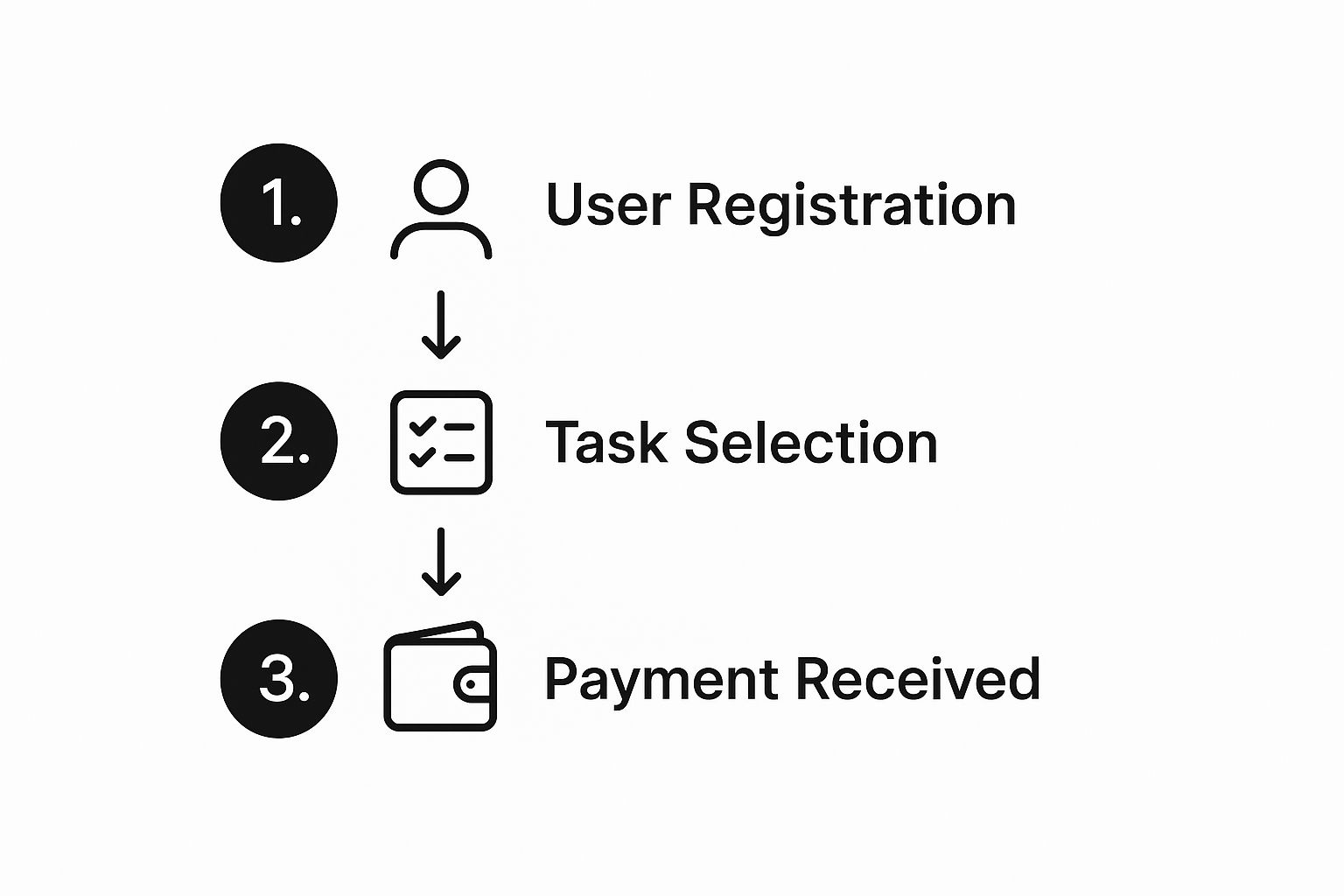Your Guide to Earn by Task Web3 Marketing

In its simplest form, the "earn by task" model is a marketing strategy where you reward community members—with tokens, NFTs, or other digital assets—for completing specific, valuable actions. It's a strategic move away from passive airdrops, designed to build a genuinely engaged and loyal user base by incentivizing meaningful contributions.
Moving Beyond Airdrops: The Rise of Earn by Task
Welcome to the new era of Web3 community building. For a long time, marketing in this space was all about simple airdrops and follower-based giveaways. Sure, these tactics could generate a quick burst of attention, but they often attracted the wrong crowd. You'd get mercenaries, not loyal advocates, which led to fleeting engagement and immediate sell-offs the moment tokens hit an exchange.
Today's Web3 user expects more. They're looking for a real connection with the projects they support and want a tangible way to contribute to their success.
This is where the earn by task model really shines. Instead of just handing out tokens and hoping for the best, you're creating a system for active participation. It’s an economy built on mutual benefit: users get real rewards for their efforts, and your project gets authentic, high-value contributions that fuel actual growth. This approach transforms a passive audience into a decentralized workforce, all motivated to see you succeed.

Why Rewarding Tasks is a Game-Changer
The psychology behind this isn't new; it taps into a huge cultural shift. The global gig economy, already valued at around $556.7 billion in 2024, shows how much people value flexible, task-based work. With about 36% of Americans already involved in side hustles, the whole "earn by task" concept feels incredibly familiar and appealing to a massive audience.
In a Web3 context, this translates into some powerful advantages for marketers:
- Laser-Focused Growth: You can steer your community’s energy toward your most pressing goals, whether that's boosting social media engagement, generating user-created content, or stress-testing a new dApp feature.
- Deeper, Quality Engagement: Asking someone to create a video tutorial or provide detailed product feedback creates a much stronger bond than a simple "like and retweet." It requires thought and effort.
- Building a Verifiable On-Chain Reputation: Every completed task provides a trackable record of a user's contributions. This lets you easily identify and reward your most dedicated supporters over the long term.
Key Takeaway: By rewarding specific actions, you’re not just buying attention; you're investing in a community that actively builds alongside you. This creates a powerful, self-sustaining ecosystem where everyone has skin in the game.
To put the power of this model into perspective, let's compare it directly to more traditional marketing efforts.
Traditional Marketing vs Earn by Task Campaigns
| Metric | Traditional Marketing | Earn by Task Model |
|---|---|---|
| User Engagement | Passive and shallow (views, clicks, likes). Often attracts a broad, uncommitted audience. | Active and deep (content creation, feedback, testing). Fosters a community of true contributors. |
| Cost & ROI | High upfront costs for ads with unpredictable ROI. Paying for impressions, not results. | Performance-based costs. You only reward completed, valuable actions, ensuring a direct ROI. |
| Long-Term Value | Creates fleeting brand awareness. Users have little incentive to stick around after the campaign ends. | Builds a loyal, invested community. Users develop an on-chain reputation and feel ownership. |
As the table shows, the 'earn by task' model consistently delivers more meaningful and sustainable results. It's about building a foundation, not just getting a temporary spike in metrics.
Platforms built specifically for this, like the no-code tools from Domino, make launching and managing these campaigns incredibly straightforward. You can design quests, automate the verification process, and distribute rewards without needing a developer. This frees you up to focus on the big picture—your strategy—instead of getting bogged down in manual admin work.
This guide will walk you through exactly how to set up and run these powerful campaigns from start to finish.
Building Your Campaign Foundation

Before you even log into Domino, let's talk strategy. A successful earn by task campaign is all about the prep work. If you dive in and start creating quests without a solid plan, you're essentially just hoping for the best—a surefire way to burn through your budget with little to show for it.
The first, most critical piece of the puzzle is defining what "success" actually looks like for you. What's the one thing you need this campaign to accomplish? Be brutally specific. Vague goals like "boost engagement" won't cut it because you can't measure them effectively.
Instead, think in concrete numbers and outcomes.
- Good Goal: "Acquire 500 new verified Discord members who complete our onboarding flow within the next 30 days."
- Even Better Goal: "Generate 100 high-quality video testimonials from active users to use in our Q3 marketing push."
Having a sharp, measurable objective like this is your North Star. It'll guide every single choice you make, from the tasks you set to the rewards you offer.
Who Are You Really Talking To?
Once your goal is set, you need to get crystal clear on who you're trying to attract. The "Web3 user" isn't a single person. This space is a vibrant mix of different tribes: DeFi degens, NFT artists and collectors, hardcore developers, and people just dipping their toes into crypto for the first time.
Your audience determines everything. You wouldn't ask a total newbie to execute a complex multi-chain swap, right? On the flip side, asking a seasoned DeFi pro to simply "follow on X" is a waste of their expertise and your rewards.
A huge mistake I see projects make is designing tasks for a generic persona. It never works. You have to get specific. Picture your ideal participant: What motivates them? Where do they hang out online? What kind of reward would actually get them excited to participate?
Getting Your Reward Pool Ready
With your goals and audience dialed in, it's time to think about the rewards. This isn't just about giving stuff away; the reward you choose sends a powerful message about your project and how much you value your community's time.
You've got a few solid options, each with its own pros and cons:
- Project Tokens: This is a classic for a reason. It gives participants a real sense of ownership and a stake in your project's future.
- Stablecoins (USDC, USDT): Don't underestimate the power of cold, hard cash. Stablecoins offer immediate, clear value and are fantastic for casting a wide net.
- NFTs: Perfect for creating a sense of identity and belonging. A unique NFT can serve as a badge of honor, proving someone was an early supporter.
As you set your budget, be mindful of the tokenomic impact. Handing out too many of your native tokens can create significant sell pressure down the line. It's a balancing act. The rewards need to be juicy enough to motivate action, but not so generous that they harm your project's long-term health. A smart reward structure is the key to a campaign that's both effective and sustainable.
Alright, you’ve done the strategic thinking. Now for the fun part: actually building and launching your first reward campaign on Domino. This is where your planning turns into a live earn by task program your community can sink their teeth into. The Domino platform is pretty intuitive, so you can get from idea to launch without a massive learning curve.
First things first, once you're in the Domino dashboard, you need to set up your reward structure. Using the reward pool you've already set aside, you'll configure exactly what users get for completing tasks. This is a crucial step—it’s where you define the economic hook that will pull people in and drive them to participate.
With the rewards defined, it's time to translate your campaign goals into specific, actionable tasks. This is where you can get really creative.
As you can see, the user's journey is a straightforward, three-stage process.

We've found that keeping the flow from registration to payment this simple is key to maximizing completion rates. Any friction and you'll see people drop off.
Defining Your Tasks and Rules
Think back to what you’re trying to achieve. Is this about blowing up your social media presence? Or are you hunting for killer user-generated content? Your tasks need to be a direct line to that goal.
For example, if social growth is the name of the game, your tasks might look something like this:
- Retweet our main announcement on X and tag two friends who are into DeFi.
- Join our official Discord, head to the #start-here channel, and react to the welcome message.
But if you’re after high-quality user-generated content, the tasks will naturally be more involved:
- Create a 30-second video explaining why you're hyped for our mainnet launch.
- Write a short thread on X about your favorite feature, making sure to include our project's cashtag.
For every single task, clarity is king. I've seen too many campaigns fizzle out because of ambiguous instructions. Be crystal clear about what a user needs to do, how they submit their proof, and what they get for it. The templates inside Domino are a great place to start if you're stuck.
Once the tasks are set, you’ll configure the validation rules. This is your first line of defense against spam and low-effort submissions. For many social tasks, like verifying a retweet or a Discord role, you can set up automated checks. For the more subjective content-based tasks, you'll probably want a manual review process to make sure the quality is there.
Setting Campaign Parameters and Security
The final step before you hit "go" is setting the guardrails for your campaign. This is all about making sure it runs smoothly, stays on budget, and remains secure. You'll handle this by tweaking a few key settings inside Domino.
Campaign Duration: Always define a clear start and end date. A campaign that runs forever loses its punch. Giving it a deadline creates a sense of urgency and gets people to act now.
User Eligibility: Decide who gets to play. You can—and should—set criteria to filter out bots. For instance, you can require social accounts to have a minimum number of followers or be a certain age. It’s a simple way to weed out freshly made spam accounts.
Anti-Fraud Measures: Make full use of Domino’s built-in tools for spotting and blocking shady behavior. These features are non-negotiable for protecting your budget and ensuring your rewards go to real community members, not a network of bots.
By taking the time to carefully set these parameters, you’re creating a fair and secure environment. This does more than just protect your assets; it builds trust with your community and makes sure the engagement you’re paying for is genuine.
Designing Tasks That Actually Create Value

The real magic of an earn by task campaign isn’t the reward—it’s the task itself. Anyone can get a user to follow a social account or drop a quick retweet. But let's be honest, that kind of engagement is fleeting and rarely leads to anything substantial. The key is to craft tasks that feel less like a chore and more like a genuine contribution to your project.
Think of it this way: a shallow task attracts a shallow participant. But a task that demands a bit of thought, creativity, or genuine feedback? That brings in a real user—someone who's actually invested in what you're building. This is your filter for finding the people who will stick around.
Think Beyond a Simple Social Follow
Let’s look at two different ways to approach this. A typical, low-effort campaign might just ask for a follow on X. Sure, your follower count goes up, but what does that really tell you? Most of those new "followers" will probably mute you the second they get their reward. It's a vanity metric, plain and simple.
Now, imagine a smarter approach that generates assets you can use for months to come.
- User-Generated Content (UGC): Instead of a follow, ask users to create a short video testimonial about why they love your platform. Suddenly, you have a library of powerful social proof.
- In-Depth Beta Testing: Launching a new feature? Design a quest that walks users through a specific workflow and asks for structured feedback. This is product research gold.
- Active Governance: Task users with reading a new proposal on your governance forum and then casting a vote in a community poll. This encourages informed participation and strengthens your ecosystem.
Tasks like these do so much more than pump up vanity metrics. They build a foundation of tangible value that directly fuels your project's growth.
A well-designed task should make the user feel like a contributor, not just a participant. When someone provides feedback that you actually implement or creates a video that you feature, they develop a sense of ownership. That's how you build a loyal, dedicated community.
Balancing Effort with Reward
Of course, the more you ask of someone, the more you need to give back. Finding that sweet spot between task difficulty and reward size is what separates a successful campaign from one that either gets ignored or overrun by bots.
This taps right into a huge economic shift. The gig economy is exploding—by 2027, an estimated 86.5 million Americans will be freelancing. People are more accustomed than ever to the idea that their time and skills are worth something tangible. Your rewards need to reflect that.
- Low-Effort (e.g., Join Discord): A small handful of project tokens or a simple POAP usually does the trick.
- Medium-Effort (e.g., Write a quality X thread): Here, you should offer a more significant token reward or perhaps a limited-edition NFT.
- High-Effort (e.g., Create a video tutorial): These tasks deserve a serious reward, like a sizable stablecoin payout or a rare, high-utility NFT.
By carefully calibrating your rewards, you create a fair system that motivates your community to take on the more challenging tasks—the ones that bring you the most value. A great way to get a feel for the market is to explore quests from other projects on Domino and see how they're structuring their rewards.
At the end of the day, your instructions must be crystal clear. The less friction a user encounters, the higher your completion rate will be, and the better your results will be.
Fine-Tuning Your Campaign for Maximum Impact
Getting your first campaign live is a huge step, but don't pop the champagne just yet. This is where the real work—and the real growth—begins. An earn by task program isn't a fire-and-forget missile; it’s a living system that needs constant attention and smart adjustments to truly deliver. Real marketing wins are built through iteration.
Your first port of call after launch should always be the Domino analytics dashboard. Think of it as your mission control. It’s where you stop guessing what’s working and start looking at hard data that tells the story of how users are interacting with your campaign.
To get a quick pulse on performance, I always start with these KPIs:
- Task Completion Rates: Are people finishing the tasks you set out? Where are they dropping off? A low completion rate is a massive red flag. It could mean your instructions are confusing, or the reward simply isn't worth the effort.
- Cost Per Acquisition (CPA): What’s it actually costing you to get a user to complete a high-value action, like joining your Discord? This number is your north star for measuring ROI.
- Social Engagement Growth: Don't get fooled by vanity metrics. Track the real-deal interactions. Are people actually joining the conversation, or are they just smashing the follow button and moving on?
Turning Data Into Action
Data is useless until you do something with it. Your goal is to use these insights to figure out what your community truly values.
For instance, if you notice that video testimonial tasks are getting completed left and right and generating incredible user-generated content, that's your cue. Double down on it. Maybe launch a few more variations with different prompts or slightly bigger rewards.
On the flip side, if that "write a blog post about us" task is collecting dust with zero takers, don't be afraid to pull the plug. It's a classic case of the effort outweighing the reward. You could either bump the reward significantly to make it worthwhile or swap it for a more bite-sized task, like crafting a killer X thread.
This cycle of tweaking and refining is what turns a one-off campaign into a predictable growth engine.
The best campaigns are never static. They evolve based on community feedback and performance data. Treat your launch as the first of many experiments to find that sweet spot between tasks and rewards.
A great way to structure this is with some simple A/B testing. You don't need a fancy, complicated setup. Just run two similar tasks with one key variable changed.
Here are a couple of ideas:
- Reward Test: For the same task, offer a 100-token reward to one group and a unique NFT to another. See which incentive gets more people to the finish line.
- Instruction Test: Does a task with a quick video tutorial outperform one with just plain text instructions? Test it and find out.
This constant loop of testing, learning, and optimizing is where you'll unlock massive improvements in your ROI.
For a more advanced approach, think about how a well-designed points system can gamify the entire experience and keep users engaged for the long haul. Learning more about implementing a point system with Domino can add a powerful new dimension to your retention strategy.
This whole idea of fair value is backed by wider economic trends. With the average freelance hourly rate in North America projected to reach $47.71 by 2025 and total US freelance earnings approaching $1.3 trillion, it’s crystal clear that people expect to be compensated fairly for their skills. By using data to optimize your rewards, you're making sure your campaign stays attractive and respects your users' time. For a deeper dive, check out these insights on the growth of the task-based gig economy to stay ahead of user expectations.
Answering Your Top Questions About Earn-by-Task Marketing
Once you start putting these campaigns into practice, you’ll naturally have questions. It’s one thing to understand the theory, but it's another to handle the real-world details of managing your budget and getting genuine, high-quality participation. Let's dig into some of the most common questions I hear from fellow Web3 marketers when they're getting their first earn-by-task campaigns off the ground.
My goal here is to help you sidestep the common hurdles and get straight to the good stuff: results.
What Are the Biggest Mistakes People Make?
Honestly, the most frequent slip-ups have little to do with the tech and everything to do with strategy. I see projects stumble in three main areas time and time again: getting the rewards wrong, writing confusing tasks, and completely forgetting about promotion.
Think about it: a reward that’s too low won’t move the needle. Nobody will bother, and your campaign will be dead on arrival. But swing too far the other way with a massive reward, and you’ll attract every bot and sybil attacker in the ecosystem, bleeding your budget for absolutely nothing.
Task clarity is just as critical. Your instructions need to be crystal clear. If someone has to spend five minutes trying to figure out what you’re asking for, they're going to click away. And finally, you can't just build it and expect them to come. You have to actively shout about your campaign from the rooftops—X, Discord, Telegram, your blog—to get people in the door.
Key Takeaway: The most damaging mistake is creating a clunky user experience. If people get frustrated, they won't just abandon the task; they might write off your entire project. A smooth, intuitive flow isn't a "nice to have," it's essential.
How Do I Keep Bots from Wrecking My Campaign?
Protecting your campaign from bots isn't about finding a single magic bullet; it's about building a layered defense. Your first line of defense is using the tools already available on a platform like Domino. This means things like verifying social accounts (X, Discord) and setting minimum standards, like account age or follower count, to weed out the fresh bot farms.
Next, get smart with your task design. A bot is great at clicking "follow" or "retweet." What it can't do is write a thoughtful, unique comment about your latest feature or give specific, human feedback on your dApp's onboarding. This is where manual review becomes your secret weapon for those higher-value tasks.
Finally, you need to be a hawk with your analytics. Keep an eye out for anything that looks fishy. Are a ton of submissions pouring in from the same handful of IP addresses? Are different accounts using the exact same phrasing in their submissions? These are giant red flags. Spotting these patterns early lets you block the bad actors and make sure your hard-earned rewards go to real community members.
Are NFTs a Good Alternative to Token Rewards?
Yes, absolutely. In fact, using NFTs as rewards is a brilliant move that can do much more than just drive action—it can forge a real sense of identity and belonging within your community. Instead of a fungible token that someone might dump on an exchange a minute later, an NFT acts as a permanent, tradable badge of honor. It’s proof they were there.
You can get really creative here:
- Campaign Souvenirs: Offer a unique, one-of-a-kind NFT to every single person who completes all the tasks in a specific campaign.
- Tiered Recognition: Create different NFT tiers—think Bronze, Silver, and Gold—based on how much a user contributed or the difficulty of the tasks they tackled.
This strategy gives your community members a tangible asset that proves their early support. From my experience, this creates a much stickier, more loyal bond than a simple cash-like transaction ever could. It’s a powerful tool to have in your earn-by-task toolkit.
Ready to turn your community into a growth engine? With Domino, you can design and launch powerful earn by task campaigns in minutes, not weeks. Start building your first quest today.
Article created using Outrank
Level Up Your dApps
Start using Domino in minutes. Use automations created by the others or build your own.
